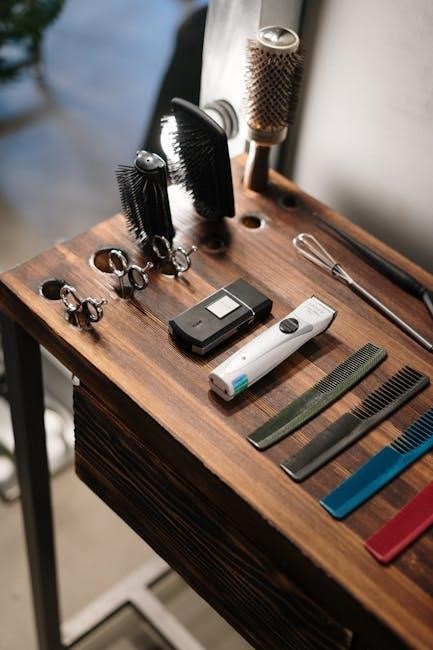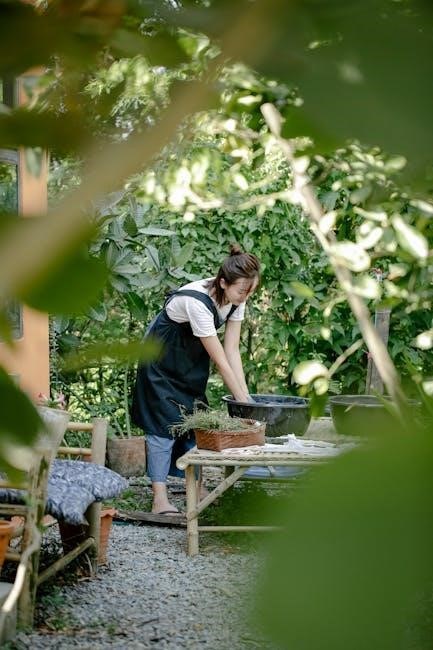
Granite‚ a natural stone known for its durability and aesthetic appeal‚ requires consistent care to maintain its beauty. Proper maintenance ensures longevity and preserves its luxurious look‚ making it a timeless choice for countertops and surfaces.
What Makes Granite Unique

Granite is a natural stone renowned for its exceptional durability‚ timeless beauty‚ and unique patterns. Its resilience to scratches and stains‚ such as those from citric acid‚ coffee‚ and wine‚ makes it a practical choice for high-traffic areas. Granite’s heat resistance adds to its versatility‚ allowing it to withstand kitchen environments. Each slab boasts distinct mineral compositions‚ creating one-of-a-kind designs that enhance any space. While granite is porous‚ proper sealing ensures it remains impervious to spills and maintains its polished appearance. Its low maintenance requirements‚ combined with its luxurious appeal‚ make granite a preferred material for countertops and surfaces. Regular care ensures it retains its elegance and functionality for years.
Importance of Proper Maintenance
Proper maintenance is crucial to preserve the beauty and durability of granite surfaces. Regular cleaning prevents dirt buildup‚ which can dull the stone’s appearance. Sealing is essential to protect granite from stains and spills‚ as it is naturally porous. Without proper care‚ granite can lose its luster and become prone to damage. Daily cleaning with mild detergents and water helps maintain its shine‚ while deep cleaning and sealing ensure long-term protection. Neglecting maintenance can lead to stubborn stains and etching‚ which are challenging to repair. Consistent upkeep not only extends the lifespan of granite but also retains its luxurious appeal‚ making it a worthwhile investment for any home.
Daily Cleaning and Maintenance
For daily upkeep‚ wipe granite surfaces with a damp‚ clean cloth. Use mild soap and water for deeper cleaning. Avoid harsh chemicals to prevent damage.
General Cleaning Tips
For daily cleaning‚ use a soft‚ clean cloth and mild soap mixed with warm water. Avoid harsh chemicals‚ abrasive cleaners‚ or acidic substances‚ as they can damage the surface. Wipe down granite surfaces regularly to prevent dirt buildup. For tougher spills‚ blot immediately to avoid staining. Never use bleach‚ vinegar‚ or ammonia‚ as they can etch the stone. Instead‚ opt for pH-neutral cleaners specifically designed for natural stone. Microfiber cloths are ideal for cleaning granite‚ as they leave no streaks or residue. Always rinse thoroughly with clean water and dry the surface to prevent water spots. Regular maintenance ensures granite retains its polished appearance and durability over time.
Tools and Supplies Needed
Maintaining granite surfaces requires the right tools to ensure effectiveness without causing damage. Essential supplies include a soft‚ lint-free microfiber cloth or sponge‚ mild dish soap‚ and warm water. For deeper cleaning‚ a granite-specific cleaner or a pH-neutral‚ non-abrasive cleaner is recommended. Avoid using bleach‚ vinegar‚ or acidic substances‚ as they can harm the stone. Distilled water is preferable to prevent mineral deposits. A clean‚ dry microfiber cloth is also necessary for drying the surface to avoid water spots. For periodic sealing‚ a high-quality granite sealer and a foam brush or clean cloth are needed. Regularly restocking these supplies ensures granite surfaces remain clean‚ protected‚ and vibrant‚ maintaining their natural beauty and durability over time.

Deep Cleaning and Stain Removal

Deep cleaning and stain removal are crucial for maintaining granite’s appearance. Regular deep cleans prevent grime buildup‚ while targeted stain treatments address spills promptly to preserve the stone’s integrity and beauty.
Deep Cleaning Techniques
For deep cleaning granite surfaces‚ use a granite-safe cleaner or a mixture of water and isopropyl alcohol (1:1 ratio). Apply the solution to the surface and let it sit for 5-10 minutes to break down stubborn stains or grime. Use a soft‚ non-abrasive sponge or microfiber cloth to scrub gently in circular motions‚ working in small sections to avoid spreading dirt. Rinse thoroughly with clean water to remove any residue. For tougher stains‚ repeat the process or use a pH-neutral stone cleaner. Avoid harsh chemicals or abrasive tools that could damage the granite. Regular deep cleaning ensures the surface remains pristine and prevents dirt buildup.
How to Remove Common Stains
Removing common stains from granite involves identifying the type of stain and using the appropriate treatment. For oil-based stains‚ apply a paste made from baking soda and water‚ cover with plastic wrap‚ and let it sit for 24-48 hours. Rinse with warm water and mild soap. For water-based stains‚ use a hydrogen peroxide solution (12%) and let it sit for 15-30 minutes before rinsing. For ink or food stains‚ a stone cleaner or poultice can be effective. Always test a small area first to ensure the solution doesn’t damage the granite. Avoid using acidic substances like vinegar‚ as they can etch the surface. Prompt action is key to preventing stains from setting in deeply.
Periodic Sealing
Regular sealing protects granite from stains and spills by creating an invisible barrier. Most granites need sealing every 1-5 years‚ depending on usage and porosity. Use a high-quality granite sealer and follow the manufacturer’s instructions for application. Testing the stone’s absorbency can help determine if sealing is necessary. Proper sealing maintains the stone’s appearance and prevents damage from everyday use. Always clean the surface thoroughly before applying a sealer to ensure optimal results. Sealing is a straightforward process that extends the lifespan of your granite surfaces‚ keeping them looking like new for years to come.
How to Test if Sealing is Needed
To determine if your granite needs sealing‚ perform a simple water test. Place a few drops of water on the surface and observe how quickly they are absorbed. If the water soaks in within 5-10 minutes‚ sealing is necessary. For a more accurate test‚ apply a small amount of oil‚ such as mineral oil‚ to the granite. If the oil leaves a dark spot or spreads slowly‚ the stone is porous and requires sealing. These tests help identify the level of protection needed to maintain the granite’s appearance and prevent stains. Regular testing ensures timely sealing‚ preserving the stone’s durability and beauty over time. This proactive approach is essential for maintaining your granite surfaces in optimal condition.
Step-by-Step Sealing Process
Begin by ensuring the granite surface is clean‚ dry‚ and free of debris. Apply the sealer evenly using a lamb’s wool applicator or clean‚ lint-free cloth. Follow the manufacturer’s instructions for the recommended amount. Allow the sealer to sit on the surface for the specified time‚ usually 15–30 minutes‚ to ensure proper absorption. Gently buff the area with a clean‚ dry cloth to remove excess sealer and achieve an even finish. Avoid applying too much product‚ as it can leave a residue. Wait 24–48 hours before exposing the surface to water or cleaning products to allow the sealer to cure fully. This process helps protect the granite from stains and maintains its appearance. Regular sealing is essential for preserving the stone’s durability and beauty over time.

Advanced Maintenance and Repair
Advanced maintenance involves addressing minor scratches and etches through professional refinishing or specialized repair kits. Regular inspections and timely interventions prevent damage escalation‚ ensuring long-term durability and aesthetic preservation.
Avoiding Common Damages
To preserve granite surfaces‚ avoid using abrasive cleaners‚ acidic substances‚ or harsh chemicals‚ as they can etch or dull the finish. Always use coasters or trivets under hot dishes and beverages to prevent thermal shock. Cutting directly on granite can scratch the surface‚ so a cutting board is essential. Regular cleaning with pH-neutral cleaners prevents dirt buildup and maintains the sealant’s effectiveness. Spills should be wiped immediately to avoid staining. Avoid standing water‚ as it can seep into the stone and cause discoloration. By following these precautions‚ granite countertops remain resistant to damage and retain their vibrant appearance for years.
Repairing Minor Damage
Minor scratches or etches on granite can often be repaired without professional help. For light scratches‚ use a granite repair kit or a polishing compound specifically designed for stone. Apply the product evenly‚ rub gently with a soft cloth‚ and rinse thoroughly. For small chips or cracks‚ a stone filler or epoxy can be effective. Ensure the area is clean and dry before applying the filler‚ then sand it smooth once cured. Regular sealing after repairs helps maintain the stone’s protective barrier. Addressing minor damage promptly prevents it from becoming more severe‚ ensuring the granite remains in optimal condition.